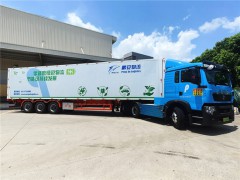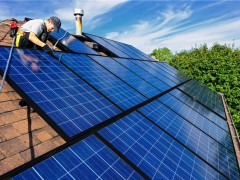據(jù)阿拉伯貿(mào)易網(wǎng)2022年5月24日紐約報(bào)道,根據(jù)來自研究公司彭博新能源財(cái)經(jīng)(BloombergNEF)的一份最新報(bào)告,到2050年前,通過額外投資7590億美元,石化產(chǎn)品可以幾乎沒有任何碳排放。
電氣化和碳捕獲和儲(chǔ)存(CCS)技術(shù)可能在減少高價(jià)值化學(xué)品(HVC)生產(chǎn)的碳排放方面發(fā)揮核心作用。HVC是制造塑料和許多制成品的關(guān)鍵原料。HVC的碳排放量占全球的2%,相當(dāng)于航空業(yè)的碳排放量,是鋁業(yè)碳排放量的兩倍。
各國政府和企業(yè)正致力于推動(dòng)石化行業(yè)在2050年前減排。盡管石化行業(yè)面臨的脫碳路徑比其他任何行業(yè)都要復(fù)雜,但與鋼鐵和水泥等其他重碳排放行業(yè)相比,石化產(chǎn)品參與者的凈零目標(biāo)涵蓋了更多的全球制造產(chǎn)能。
彭博新能源財(cái)經(jīng)發(fā)布的題為《石化產(chǎn)品脫碳:凈零排放途徑》的報(bào)告概述了低排放化學(xué)品的途徑,并描述了降低CCS和電氣化成本如何在總產(chǎn)量顯著增長的情況下將排放降低到凈零碳排放。
彭博新能源財(cái)經(jīng)估計(jì),與常規(guī)產(chǎn)能增長相比,新的清潔產(chǎn)能和為降低排放而進(jìn)行的改造將使石化行業(yè)額外花費(fèi)7590億美元。據(jù)彭博新能源財(cái)經(jīng)估計(jì),到2050年前,全球能源部門脫碳需要172萬億美元,而這大約是其中的1%。
資本支出密集,但至關(guān)重要
化學(xué)品去碳將是資本支出密集,但它對2030年以后的所有新增產(chǎn)能和改造達(dá)到凈零,以避免資產(chǎn)在其長期使用期內(nèi)擱淺的風(fēng)險(xiǎn)來說至關(guān)重要。
到2050年前,CCS將成為最便宜的零排放石化產(chǎn)品的選擇,并減少40%的HVC生產(chǎn)的碳排放。 另外35%將依賴新的電氣化裂解裝置設(shè)計(jì),這可以提供唯一的凈零生產(chǎn)路線,與傳統(tǒng)的蒸汽裂解裝置相比具有成本競爭力。報(bào)告稱,生物塑料是目前唯一可在市場上獲得的凈零排放途徑,但由于成本高和缺乏可持續(xù)的生物質(zhì),到2050年前,生物塑料將僅占市場的2.5%。
CCUS很可能扮演的重要角色,對于已經(jīng)擁有該技術(shù)專長并可能加速成本下降的綜合性石油巨頭來說,是一個(gè)獨(dú)特的機(jī)會(huì)。石油公司一直在探索擴(kuò)大石化領(lǐng)域的足跡,以對沖燃料需求下降的風(fēng)險(xiǎn)。 報(bào)告稱,如果這些石油巨頭將其CCUS投資的重點(diǎn)轉(zhuǎn)向下游資產(chǎn),它們可能通過擴(kuò)大凈零石化生產(chǎn),壓低整個(gè)行業(yè)的成本,從而引領(lǐng)轉(zhuǎn)型。
需要煉油企業(yè)的幫助
沒有煉油企業(yè)的幫助,石化產(chǎn)品供應(yīng)鏈將無法脫碳。目前,世界上大部分的芳香烴供應(yīng)都是從煉油企業(yè)作為燃料生產(chǎn)的副產(chǎn)品采購的,芳香烴是諸如PET瓶等產(chǎn)品的關(guān)鍵化學(xué)成分。在凈零排放的情況下,由于運(yùn)輸燃料需求達(dá)到峰值,煉油企業(yè)將在2030年開始停產(chǎn),然后乘用車電氣化將導(dǎo)致燃料需求開始下降。這就留下了芳香烴供應(yīng)的缺口,目前只能通過使用綠色甲醇原料來解決——這是一條昂貴的路線,將使許多化學(xué)品的價(jià)格提高兩倍。這一過程將占化學(xué)品生產(chǎn)的20%,目前這一比例為0%,除非煉油商大幅轉(zhuǎn)向?qū)W⒂诨瘜W(xué)品生產(chǎn),同時(shí)對業(yè)務(wù)進(jìn)行脫碳。
彭博新能源財(cái)經(jīng)的研究顯示,到2050年,盡管成本大幅下降,但低碳路線的成本仍將高于目前的生產(chǎn)成本。這可能導(dǎo)致持續(xù)的綠色溢價(jià),并創(chuàng)造強(qiáng)有力的激勵(lì),以凈零要求取代或減少塑料和化學(xué)品在市場上的使用。化學(xué)品是許多工業(yè)供應(yīng)鏈的關(guān)鍵投入物,因此對它們進(jìn)行脫碳可能會(huì)增加多個(gè)行業(yè)的成本。除非成本大幅加速下降,否則納稅人很可能會(huì)通過提高價(jià)格或補(bǔ)貼的方式,為長期的減排買單。
彭博新能源財(cái)經(jīng)可持續(xù)材料分析師、該報(bào)告的主要作者伊爾汗·薩沃特表示:“如果石化行業(yè)有些許希望實(shí)現(xiàn)凈零排放,那么就必須在2030年前開始大規(guī)模資本支出。”“在短期內(nèi),部署這些技術(shù)將是昂貴的,但它可以使石化行業(yè)走上低成本的脫碳道路。鑒于化工企業(yè)的資產(chǎn)壽命較長,它們必須迅速行動(dòng),盡快為凈零項(xiàng)目提供資金,否則就有可能被鎖定在關(guān)鍵技術(shù)之外。今天的投資將是管理長期成本和支付2035年后股息的關(guān)鍵。”
如果綠色塑料在使用壽命結(jié)束時(shí)燃燒,它們就不再是凈零排放。“雖然許多凈零目標(biāo)不包括范圍3的排放,但客戶和投資者將把焚燒的塑料與石油和化學(xué)品公司聯(lián)系起來,就像他們對待塑料垃圾那樣。整個(gè)供應(yīng)鏈都是塑料生產(chǎn)商的問題,”彭博新能源財(cái)經(jīng)可持續(xù)材料主管朱莉婭?阿特伍德如是表示,“低碳石化行業(yè)將需要循環(huán)經(jīng)濟(jì)行動(dòng)。 生產(chǎn)商已經(jīng)在與煉油企業(yè)和廢物管理機(jī)構(gòu)合作,以獲取循環(huán)和低碳原料。”
盡管目前大多數(shù)凈零產(chǎn)能是由客戶對可持續(xù)塑料的需求推動(dòng)的,但政策制定者也可以啟動(dòng)石化行業(yè)的脫碳。碳定價(jià)常常被吹捧為一種脫碳杠桿,但要激勵(lì)變革,需要非常高的價(jià)格。在250美元/噸二氧化碳的情況下,80%的凈零排放HVC產(chǎn)能將具有競爭力。目前歐洲的二氧化碳排放價(jià)格約為90美元/噸,而工業(yè)排放國看到的價(jià)格實(shí)際上要低得多,這要?dú)w功于慷慨的免費(fèi)配額。報(bào)告說,為了鼓勵(lì)更快的行動(dòng),政府可以為早期采用者提供長期補(bǔ)貼,以證明更高的生產(chǎn)成本是合理的,并投資于基礎(chǔ)設(shè)施,如二氧化碳運(yùn)輸和儲(chǔ)存網(wǎng)絡(luò)以及提供24/7(每周7天每天24小時(shí))清潔電力的電網(wǎng)。
李峻 編譯自 阿拉伯貿(mào)易網(wǎng)
原文如下:
$759bn needed for a net-zero petchem sector by 2050: study
Petrochemicals could be made with almost no carbon emissions by investing an extra $759 billion by 2050, according to a new report from research firm BloombergNEF (BNEF).
Electrification and carbon capture and storage are likely to play a central role in reducing emissions from the production of high-value chemicals, or HVCs, which are key feedstocks used to make plastics and many manufactured goods. HVCs are responsible for up to 2% of global emissions, equivalent to aviation, and double the aluminum industry’s contribution.
Governments and corporate net-zero commitments are pushing the petrochemicals industry to cut its emissions by 2050. Despite facing a more complex decarbonisation path than any other sector, petrochemicals players’ net-zero targets cover more of the global manufacturing capacity than other heavy emitters like steel and cement.
The report “Decarbonizing Petrochemicals: A Net Zero Pathway” outlines a pathway to low-emissions chemicals and describes how a combination of falling carbon capture and storage (CCS) and electrification costs could reduce emissions to net zero, even while total production grows significantly.
BNEF estimates that new clean capacity and retrofits for lower emissions will cost the petrochemicals industry an additional $759 billion compared to business-as-usual capacity growth. This is roughly 1% of the $172 trillion estimated by BNEF to be needed to decarbonise the global energy sector by 2050.
Capex intesive but crucial
Decarbonising chemicals will be capex-intensive, but it is crucial for all new capacity and retrofits beyond 2030 to be net-zero, to avoid the risk of stranding assets over their long lifetimes.
By 2050, CCS could be the cheapest option for net-zero petrochemicals and abate the emissions of 40% of HVC production. Another 35% would rely on new electrified cracker designs, which could provide the only net-zero production route that is cost-competitive with conventional steam crackers. Bioplastics, which are the only commercially available net-zero route today would capture only 2.5% of the market by 2050, due to high costs and a lack of sustainable biomass, says the report.
The important role that CCUS is likely to play is a unique opportunity for integrated oil majors, which already have expertise in the technology and could accelerate cost declines. Oil companies have been exploring a greater footprint in the petrochemicals space as a hedge against declining fuel demand. If these companies shift the focus of their CCUS investments into downstream assets, they could lead the transition by expanding net-zero petrochemicals production and driving down costs for the entire sector, it says.
Refiners' help needed
The petrochemicals supply chain cannot decarbonise without the help of refiners. Currently, most of the world’s supply of aromatics, a key chemical ingredient in products like PET bottles, is sourced from refineries as a by-product of fuel production. In a net-zero scenario, refinery retirements start in 2030 as demand for transport fuels peaks and then begins to fall due to passenger car electrification. This leaves a gap in aromatics supply that can currently only be addressed by using green methanol feedstock – an expensive route that would triple the price of many chemicals. This process would account for 20% of chemicals production, up from 0% today, unless refiners make a dramatic pivot to focus on chemicals production while simultaneously decarbonising their operations.
BNEF’s research shows low-carbon routes will remain more expensive than today’s production, despite some steep cost declines, in 2050. This could lead to persistent green premiums and create strong incentives to replace or reduce plastic and chemicals use in markets with net-zero mandates. Chemicals are crucial inputs to many industrial supply chains, so decarbonizing them could increase costs across several sectors. Unless cost declines are significantly accelerated, taxpayers will likely pay for long-term abatement either through higher prices or subsidies.
“Large-scale capex spending must start before the end of the decade if the petrochemical industry has any hope of reaching net-zero,” said Ilhan Savut, sustainable materials analyst at BNEF and lead author of the report. “Deploying these technologies will be expensive in the short term, but it could set the sector on a lower-cost decarbonization path. Given their long asset lifetimes, chemicals players must move quickly and fund net-zero projects as soon as possible, or risk getting locked out of key technologies. Investments today will be key to managing longer-term costs and pay dividends post-2035.”
If green plastics are burned at the end of their life, they are no longer net-zero. “While many net-zero targets do not cover Scope 3 emissions, customers and investors will link incinerated plastic to oil and chemicals companies, as they did with plastic waste. The whole supply chain is a plastic producer’s problem,” said Julia Attwood, head of sustainable materials at BNEF. “A low-carbon petrochemical sector will require circular economy action. Producers are already working with refiners and waste managers to source circular and low-carbon feedstocks.”
While most net-zero capacity today is being driven by customer demand for sustainable plastics, policymakers can also kick-start decarbonisation in petrochemicals. Carbon pricing is often touted as a decarbonisation lever, but very high prices would be needed to incentivise change. At $250/tCO2, 80% of all net-zero HVCs production would be competitive with unabated production. Current prices in Europe sit at about $90/tCO2, and the prices seen by industrial emitters is actually much lower, thanks to generous free allowances. To incentivise quicker action, governments can provide longer-term subsidies to early adopters to justify higher production costs and invest in enabling infrastructure such as CO2 transport and storage networks and grids providing 24/7 clean power, the report said.
免責(zé)聲明:本網(wǎng)轉(zhuǎn)載自其它媒體的文章及圖片,目的在于弘揚(yáng)石化精神,傳遞更多石化信息,宣傳國家石化產(chǎn)業(yè)政策,展示國家石化產(chǎn)業(yè)形象,參與國際石化產(chǎn)業(yè)輿論競爭,提高國際石化產(chǎn)業(yè)話語權(quán),并不代表本網(wǎng)贊同其觀點(diǎn)和對其真實(shí)性負(fù)責(zé),在此我們謹(jǐn)向原作者和原媒體致以崇高敬意。如果您認(rèn)為本站文章及圖片侵犯了您的版權(quán),請與我們聯(lián)系,我們將第一時(shí)間刪除。







